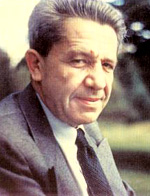Alfred Schütz
From Geography

The work of Alfred Schütz was involved with influences of different streamings like Symbolic interactionism and Ethnomethodology. His most famous work is Phenomenology of the Social world (Campbell, 1991).
Schütz tries to bring the social system in front of the concept of action. He sees it as a basic element. He tries to explain spatial action by using social systems. Husserl had a great influence on the methodology of Schütz. His method was examining of phenomena as they occure. This is called 'the stream of consciousness'.
Beside that Schütz is saying that meaning is produced by acting and knowing. He takes the subject as a basis of social reality. Social reality can be subscribed as intersubjectively created reality, everbody has his own reality, so the social reality is in between (Werlen, 2010). Example of this is a song that's played. For one person it can be expierenced as the most beautiful song in the world, for another person it can be the most worse noise ever. According to Schütz there are different 'meaning-context's, namely because motives and in-order-to motives (Campbell, 1981, p.204). Because motives explain an action by reference to the past, instead of a reference to the future. In-order-to motives show the freedom of action of an actor. The actor experiences oneself as free and responsible.
Schütz is also talking about the shared stock of knowledge. The shared knowledge is existing of one shared body of perceptions or interpretations of a subject, altough every person has his/her own view about a subject. This common shared interests (the 'stock of knowledge') is what he calls social reality. This can also be translated in spatial context (Campbell, 1991).
Space is a construction of reality. Basic coordinates are experiences of the body and brain. There are many different concepts of space, because we are all making spaces ourselves. A good thing to know is that Schütz notes that there are no spaces existing in itself. We only see things as spatial, because our own body shares the space with other things (Werlen, 2010).
Human beings as social creatures
Alfred Schutz assumes human beings to be social creatures. He states that consciousness of daily life is a social consciousness in two different ways (Campbell, 1981, p. 205). Firstly, a conscious person automatically takes for granted the existence and the presence of other people as inhabitants of the same world as in which the individual lives. This becomes especially apparent in social action, which takes into account the reactions of others and their assumed knowledge of the situation as it is (Campbell, 1981, p. 206).
Another reason why Schutz states that human beings are social beings is the fact that an individual and his conciousness uses typifications that are communicated to him or her by groups of individuals in this shared world: a historically given world (Campbell, 1981, p. 206). For instance: a person who is born and raised in the Netherlands will speak Dutch and will use signs and symbols which are apparent for 'being Dutch'. These are the typfications that set forth the nature of the socio-cultural world itself. The individual takes over the typifications which are 'created' and 'maintained' by parents, friends, ancestors, etc. and therefore the human being is a social being.
References
Campbell, T. (1981). Seven Theories of Human Society. Oxford: Clarendon Press.
Campbell, J. (1991). Alfred Schütz. New York: Penguin
Contributors
Published by Bas Boselie & Chriss van Pul
Page outline enhanced, page enhanced, links added and image inserted by Aafke Brus --AafkeBrus 11:51, 24 October 2011 (CEST)
Page improved by Lars-Olof Haverkort --LarsHaverkort 17:12, 12 September 2012 (CEST)